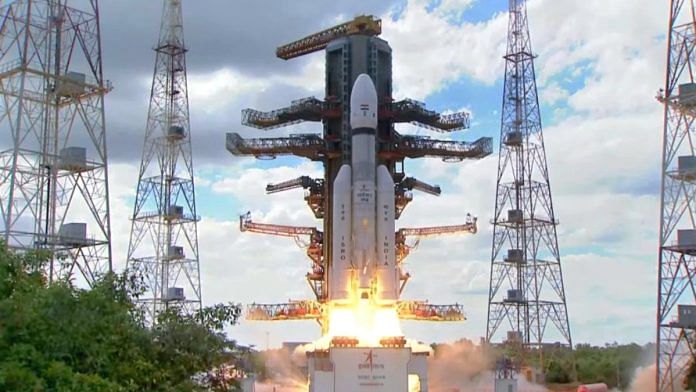Sriharikota: The Indian Space Research Organisation’s (ISRO) third lunar mission, Chandrayaan-3, successfully took off amid loud cheers from the second launch pad of the Satish Dhawan Space Centre at Sriharikota, Andhra Pradesh.
Although this is India’s third tryst with the moon, it is the country’s second attempt to soft-land at the lunar south pole. Conceptualised as a tech demonstrator aimed to assess its landing and roving capabilities, the mission carries the lander called Vikram, which is expected to touch down on 23 August.
The landing, if successful, will make India the fourth country to do so after the United States, the former Soviet Union, and China.
The mission’s success is also critical for another reason — it will set the ball rolling for the Indo-Japanese Lunar Polar Exploration Mission, a robotic lunar mission conceptualised by ISRO and Japan Aerospace Exploration Agency (JAXA) for 2025.
This mission’s lander, Vikram, and rover, Pragyan, have the same names — although with upgraded design — as those of the second lunar mission, Chandrayaan-2. The lander Vikram — named after the father of the Indian space program Vikram Sarabhai — had crashed during the second mission on 6 September 2019, which also destroyed the rover Pragyan.
In less than half an hour of the launch, ISRO scientists announced the successful separation of the satellite from the launch vehicle. The satellite was injected into the desired orbit to begin its journey to the Moon
ISRO chairman S. Somanath and Project Director P. Veeramuthuvel could barely contain their delight as colleagues cheered them on.
The space agency confirmed: “Chandrayaan-3, in its precise orbit, has begun its journey to the Moon. Health of the spacecraft is normal.”
#WATCH | #Chandrayaan3 project director P Veeramuthuvel and ISRO chief S Somanath share their delight after the LVM3 M4 vehicle successfully launched it into orbit.
"Chandrayaan-3, in its precise orbit, has begun its journey to the Moon. Health of the Spacecraft is normal," says… pic.twitter.com/nL52Ue5e7D
— ANI (@ANI) July 14, 2023
Union Minister of State for Science and Technology Jitendra Singh, who was present at the launch, congratulated Somanath and presented him with a golden miniature of the spacecraft.
Prime Minister Narendra Modi said that Chandrayaan-3 had scripted a “new chapter in India’s space odyssey.
“It soars high, elevating the dreams and ambitions of every Indian. This momentous achievement is a testament to our scientists’ relentless dedication. I salute their spirit and ingenuity!” Modi tweeted from Paris where he was the guest of honour at the Bastille Day Parade.
Chandrayaan-3 scripts a new chapter in India's space odyssey. It soars high, elevating the dreams and ambitions of every Indian. This momentous achievement is a testament to our scientists' relentless dedication. I salute their spirit and ingenuity! https://t.co/gko6fnOUaK
— Narendra Modi (@narendramodi) July 14, 2023
Also Read: Testing capabilities, setting stage for 2025 moon mission — what’s the purpose of Chandrayaan-3
Payloads
Launched on the Launch Vehicle Mark-III, or LVM3 — a vehicle earlier known as GSLV, which had been used previously to launch Chandrayaan-2 – the primary objective of the mission is to demonstrate ISRO’s ability to make a soft landing on the lunar surface. It is also aimed at successfully operating a robotic craft on the lunar surface remotely.
The Vikram lander, which is 8 ft 4 in × 6 ft 7 in × 3 ft 11, carries several payloads, among them the Chandra’s Surface Thermophysical Experiment (ChaSTE) to measure the thermal conductivity and temperature, Instrument for Lunar Seismic Activity (ILSA) to measure seismic activities around the landing site, and Langmuir Probe (LP) to estimate Moon’s surface plasma density and its variations.
In addition, a passive Laser Retroreflector Array from the National Aeronautics and Space Administration has also been accommodated for lunar laser ranging studies. This is meant to measure the distance between the Earth and the Moon using lasers fired from earth and reflected back from the moon.
The rover, Pragyan, will carry an Alpha Particle X-ray Spectrometer (APXS) and Laser Induced Breakdown Spectroscope (LIBS) for studying the composition of the soil at the landing site.
Besides these, there’s another payload — the Spectro-polarimetry of Habitable Planet Earth (SHAPE). Carried by the vehicle’s propulsion module — the unit that will help place the lander in the correct lunar orbit — SHAPE will peer into the cosmos to look for signs of a potentially habitable planet.
Landing
As for the trajectory, Chandrayaan-3 will follow a path similar to its predecessor, Chandrayaan-2. Since this mission has no orbiter, it’s the mission’s propulsion module, with its payload SHAPE, that will orbit the Earth several times, performing orbit-raising manoeuvre — that is, use its propulsion systems to change its orbit — until it is within Moon’s gravitational pull.
Once there, the module will adjust its orbit to a circular path of about 100 x 100 km above the Moon’s surface before a landing is attempted on 23 August. However, ISRO could reschedule this if it deems necessary.
Once it has safely landed, the rover, Pragyan, will exit the lander and explore the surface. The 26 kg vehicle, equipped with solar panels, will move at the speed of 1 cm/sec.
Both Vikram and Pragyan are expected to function for one lunar day or 14 Earth days, beyond which the lack of sun will cause the mission to lose power and the extreme cold of the lunar night will throttle its structure and equipment.
(Edited by Uttara Ramaswamy)
Also Read: Gaganyaan delayed as ISRO developing in-house life support for astronauts, says agency chief



